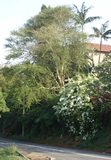Weaver species category
Choose different species category from drop-down list and press 'Go' button.Genus Amblyospiza
The Thick-billed Weaver is a unique weaver, placed in its own genus. Although a few early authors placed it in a variety of genera (eg. Pyrenestes or Coryphegnathus), for the last century it has consistently remained in Amblyospiza. The sexes are dissimilar. It is polygynous. The nest is woven with thin reed strips and plced between upright reeds. The nest is globe shaped with a side entrance near the top. The entrance is narrowed down in breeding nests. Thick-billed Weavers feed on insects, fruit and hard-shelled seeds. They breed in wetlands but forage in forest edges and gardens when not breeding.Some subspecies differences in male plumages:

Figures from:
capitalba - Shelley 1905b; melanota - PHOWN 8334; montana - PHOWN 8334; unicolor - specimen ZMB_25661; albifrons - Smith 1840a.
subspecies head upper under other capitalba rufous-brown dark chocolate-brown grey-brown white forehead patch to crown; large contrasts melanota dark brown black dark brown to grey dark head contrasts with black upperparts,
link between montana & unicolor
montana black black blackish very dark, nearly black unicolor black but brown wash black-brown black-brown smaller, no obvious colour contrast albifrons brown dark brown grey-brown
There is less variation in female plumage, but generally they are paler in populations with rufous-headed males.
Read about the Thick-billed Weaver Amblyospiza albifrons










